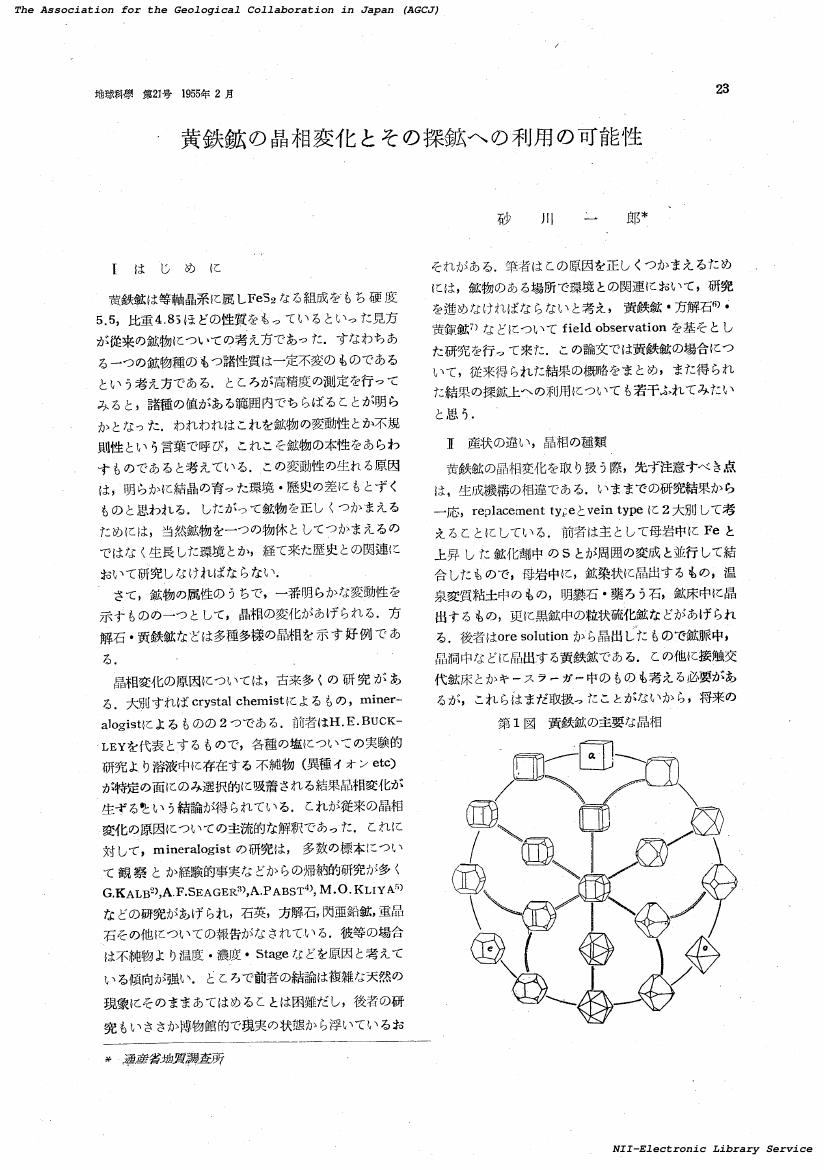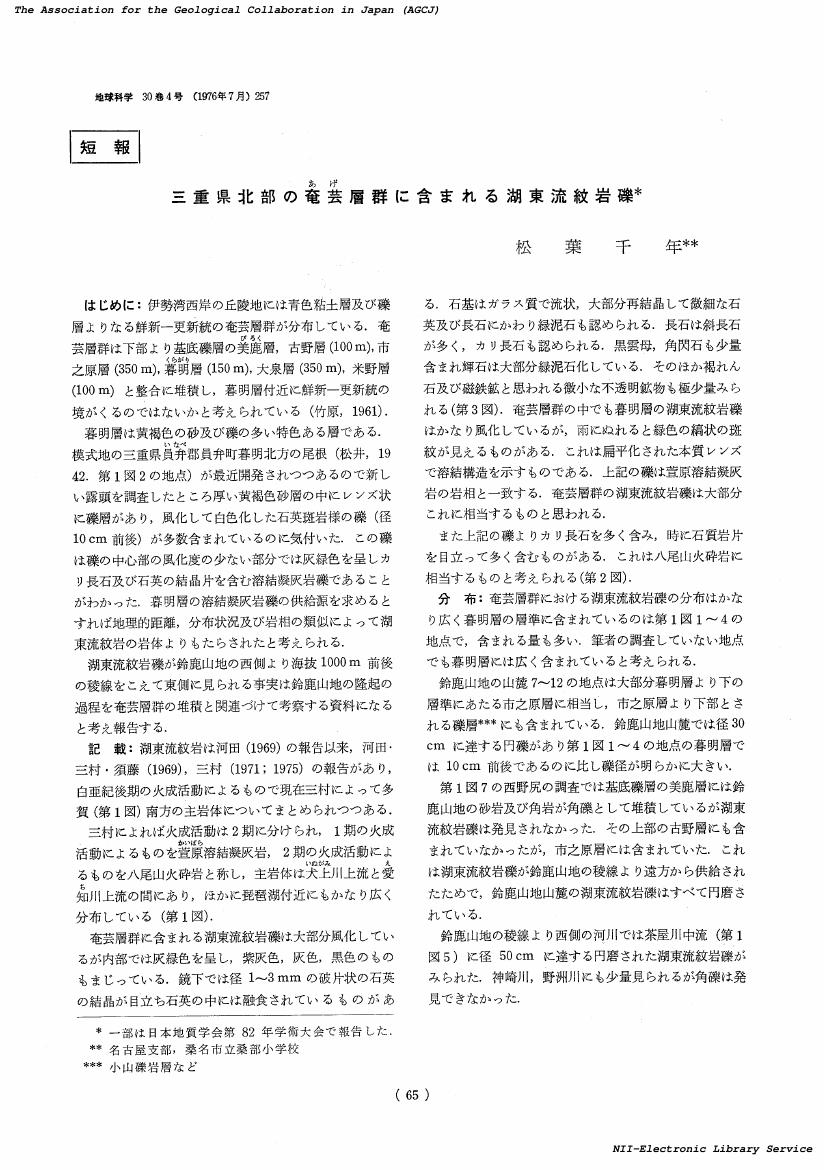1 0 0 0 OA 北海道中央部石狩低地帯東縁長沼地域の中 : 上部更新統層序と古環境
- 著者
- 能條 歩 金川 和人 星野 フサ 岩見沢団体研究グループ
- 出版者
- 地学団体研究会
- 雑誌
- 地球科学 (ISSN:03666611)
- 巻号頁・発行日
- vol.62, no.5, pp.307-323, 2008-09-25 (Released:2017-05-16)
石狩低地帯東縁の長沼地域には,追分層,馬追層,山根川層,北長沼層,茂世丑層などの新生界が分布する.本研究によって示された有孔虫化石,花粉化石,火山灰などのデータに基づきこれらの地層の層序および堆積年代,古環境に関して以下の結論を得た.(1)全ての地層はそれぞれ不整合関係にある.(2)長沼地域の火山灰層はMpfa1,Mpfa3,Aso-4,Aafa2(Toya),Aafa4および早来層中の火山灰層に対比される.(3)馬追層と山根川層はともに中期更新世の温暖期の堆積物であり,馬追層はMIS11に,山根川層はMIS9に堆積したものと考えられる.(4)北長沼層堆積期のMpfa1降灰期は,最終氷期最寒冷期並の寒冷期であった.
1 0 0 0 東北日本弧背弧,鮮新統久六島玄武岩のSr-Nd同位体組成
1 0 0 0 OA 単層の解析 その実際と堆積学的意義について
- 著者
- 平山 次郎 鈴木 尉元
- 出版者
- 地学団体研究会
- 雑誌
- 地球科学 (ISSN:03666611)
- 巻号頁・発行日
- vol.22, no.2, pp.43-62b, 1968-03-25 (Released:2017-07-26)
A sedimentological study was made of the Flysch-type alternations of Otadai formation, Kazusa group deposited in the central part of the Boso peninsula in upper Pliocene epoch (Fig. 2). The formation consists of rhythmic alternation of sandstone and mudstone and the relative amounts of the two rocks vary in places. Each layer is correlated for more than 30 km in extent, as it has their own characteristics in thickness, texture, composition and colour and is arranged in similar manner at the neighbouring sections (Fig. 3, 4). Several key beds of tuff are the most important in the correlation because of their distinct features. The shape, textural distribution and grain size variation in the layers has been definitely shown by the method stated above. The thicker each layer of sandstone is, the more spacial extent it acquires in general. The layer over 10 cm in thickness at the thickest part reaches more than 30 km in extent. It is asymmetrical in shape owing to the more rapid decrease toward west (Fig. 6). On the other hand, the thickness of mudstone layers increases gradually toward west within the studied area but seems to decrease very rapidly westward (Fig. 5). It is concluded that the thickness variation of sandstone and mudstone assembly is determined by sandstone, that is, the layers of sandstone are very sensitive to the subsidence of the basin. Of course, the subsidence is the neccessary condition for the formation of layers. A layer consists of lamina which are units of mass movement of grains, as will be seen from the Photo. 1. A relatively thick sandstone layer is divided into three intervals based on the nature of lamina, namely, massive graded, parallel-laminated and cross-laminated intervals from the base respectively. But a thin sandstone layer is devoid of massive graded interval and/or parallel-laminated intervals. The arrangement of these lamina is closely related to the thickness variation of a layer (Fig. 6). The grain size distribution and consituents in a layer are also related to the textural arrangement as well as the shape (Fig. 9). The boundaries of textures are nearly parallel to the isometrical lines of median diameter of grain size and sorting coefficient. Shell fragments are concentrated at the bottom of the graded interval, while pumice and plant fragments are often seen in the parallel and cross-laminated intervals. The grain size variation in the mudstone layer seems to be more monotonous and the mean size and sand grain content gradually decrease toward west. As will be known from the fact stated above, sandstone layers are very different from mudstone layers in many respects. And it is observed that the sandstone layer is formed by different way from the mudstone. The inference is substanciated by the difference of faunal assemblages found in both layers. The sandstone has the shell fragments and worn-out foraminifers which are found in the upper neritic zone in the recent environment, while molluscan shells and foraminifers contained in the mudstone are similar to the fauna living in the bottom over 400 m in depth in the Pacific off the Boso peninsula. This fact indicates that sand deposited temporarily under the bottom of shallow sea is transported into the bathyal environment where mud is usually deposited. The direction of current transporting sand grains should be from west to east as is assumed from the sole markings developed under the bottom of sandstone layers and cross laminations (Fig. 10). The nature of flow is inferred from the result of laboratory experiments and observations of alluvial channels. It is controlled by many variables such as depth, slope, size and shape of grains, viscosity and density of sediment-water mixture, etc. So the concept of flow regime (SIMONS & RICHARDSON, 1961) is very useful as it allows grouping of the combined effects of those factors. The classification of flow regime is based on form of(View PDF for the rest of the abstract.)
1 0 0 0 OA 黄鉄鉱の晶相変化とその探鉱への利用の可能性
- 著者
- 砂川 一郎
- 出版者
- 地学団体研究会
- 雑誌
- 地球科学 (ISSN:03666611)
- 巻号頁・発行日
- vol.1955, no.21, pp.23-30, 1955-02-25 (Released:2017-07-22)
1 0 0 0 OA 高槻北方丘陵の大阪層群 近畿地方の新期新生代層の研究,その17
- 著者
- 西山団体研究グループ 桂高校地学クラブ
- 出版者
- 地学団体研究会
- 雑誌
- 地球科学 (ISSN:03666611)
- 巻号頁・発行日
- vol.24, no.6, pp.208-221, 1970 (Released:2017-07-26)
The stratigraphy of the Osaka Group in surveied area is as follows; [table] This stratigraphy is well accorded with that of the other hills which made of the Osaka Group; for example, Senriyama,Ibaraki and Hirakata Hills. Tomistoma sp. and many plant fossils yielded in this area as shown in Table 2. The paleocurrent directions deduced from cross beddings and inclination of gravels were obtained. The results are summarized in Figs. 9 and 10. Paleocurrent directions are clearly divided into two groups ; that is, from northeast to southwest and from southeast to northwest. The former may be products of the ancient river Akuta and the latter may be from the ancient river Yodo. These two directions are found at same cliff in several places.
- 著者
- 日下 哉 鹿島 愛彦 伊藤田 直史 能條 歩 美利河海牛調査研究会
- 出版者
- 地学団体研究会
- 雑誌
- 地球科学 (ISSN:03666611)
- 巻号頁・発行日
- vol.50, no.5, pp.403-407, 1996
- 参考文献数
- 10
- 被引用文献数
- 1
1 0 0 0 OA 最終間氷期とその気候変動について
- 著者
- 秋山 雅彦
- 出版者
- 地学団体研究会
- 雑誌
- 地球科学 (ISSN:03666611)
- 巻号頁・発行日
- vol.62, no.1, pp.5-15, 2008-01-25 (Released:2017-05-16)
- 被引用文献数
- 6
最終間氷期は,エーム期および深海底堆積物層序のMIS 5eと同時期を示す用語とされることが多い.しかし,エーム期は後期更新世の開始期として国際的な標準層序に位置づけ13.1万年前〜11.6万年前と定義し,最終間氷期については12.5万年前にヨーロッパにおける樹木花粉が卓越することで特徴付けられる温暖期とすることが望ましい.IPCCによる今世紀末の気温上昇の予測は,循環型社会シナリオとされるB1シナリオでも,1.1〜2.9℃とされ,放射強制力の変化は0.6〜2.4W/m2とされている.最終間氷期の気温上昇の直接的原因は地球軌道の変化による放射強制力の増加で,全地球平均の上昇値は僅かに0.2W/m2とされているが,北極地域の夏の時期ではその値は60W/m2に及ぶ.このことによる最終間氷期の気候変動はきわめて大きく,それに伴う海面上昇も大きかったことが分かっている.近年の急激な気温や海水面の上昇はこれまで人類が経験したことのないほど急激な現象であると報道されることが多い.しかし,最終間氷期の気候変動が現在のそれを越える規模であったことを考えると,産業革命以降になって化石燃料の燃焼による人為的な要因と区別して,自然要因の解明を行うことが是非とも必要になろう.
1 0 0 0 OA 蓮華帯若桜地域に分布する青色片岩の変成作用:変成相平衡とP-T経路
- 著者
- KABIR Md. Fazle 高須 晃
- 出版者
- The Association for the Geological Collaboration in Japan
- 雑誌
- 地球科学 (ISSN:03666611)
- 巻号頁・発行日
- vol.75, no.1, pp.19-32, 2021-01-25 (Released:2021-04-03)
- 参考文献数
- 54
蓮華変成帯若桜地域に分布する青色片岩には昇温期,ピーク,そして降温期の 3つのステージの変成作用が記録されている.昇温期変成作用は片理を構成する鉱物に包有される鉱物群(緑泥石,緑れん石,フェンジャイト,曹長石,ウィンチ閃石/藍閃石,パラゴナイト,赤鉄鉱,石英)によって定義される.ピーク変成作用は片理を構成する鉱物(藍閃石/マグネシオリーベック閃石,緑れん石,フェンジャイト,緑泥石,チタン石,赤鉄鉱,石英)によって定義される.昇温期とピークの変成温度圧力を Na2O-CaO-K2O-FeO-MgO-Al2O3-SiO2-H2O-O2 (NCKFMASHO)系の相平衡モデル(シュードセクション・モデリング)により推定した.フェンジャイトと緑泥石の組成等値線から,昇温期変成条件は 300-320℃,0.5GPa,また,ピーク変成条件は 350-390℃,1.05-1.2GPa(ローソン石藍閃石片岩相または緑れん石藍閃石片岩相)であることが明らかにされた.片理を形成する角閃石の縁部(ウィンチ閃石~アクチノ閃石)およびピーク変成鉱物を置換する緑泥石とカリ長石の組み合わせより,360-400℃,0.4-0.5GPaの降温期変成条件が得られた.これらの昇温期,ピーク,降温期変成条件の推定より,若桜の青色片岩は変成ピーク後の岩体上昇初期に定温降圧を伴う時計回りP-T経路を経て形成されたことがわかる.このような定温降圧を伴うP-T経路は,ピーク変成条件は異なるが,周防帯に属する江津地域の青色片岩と類似する.
1 0 0 0 OA 三重県北部の奄芸層群に含まれる湖東流紋岩礫
- 著者
- 松葉 千年
- 出版者
- 地学団体研究会
- 雑誌
- 地球科学 (ISSN:03666611)
- 巻号頁・発行日
- vol.30, no.4, pp.257-259, 1976-07-20 (Released:2017-07-26)
- 被引用文献数
- 1
関東平野を横断する利根川に沿って,低地が広く発達している.この発達は関東造盆地運動によると云われている.最近,この地域の考古遺跡発掘調査あるいは低地における大規模な土木工事などにより.表層とくに浅い地層の観察・検討が行われるようになってきた.その結果,この地域の新しい歴史時代の地殻変動あるいは地質環境変遷の具体的な事象が明らかになりつつある.利根川中流低地下流側の加須低地では,古い台地地形が地下に埋没しており,「埋没台地」と呼ばれ,特異な低地地形を作っている.この台地の埋没は,古墳時代以降約3mに及んでおり,加須低地における新しい時代の沈降運動は,大きなものであることを示している.また,上流側の妻沼低地では,9世紀(弘仁9年,818)に生じた「古代地震」の液状化による「地下の割れ目系」およびそれを充填する「噴砂・脈状砂」が各所で発見されている.これらの結果をまとめると,古代地震の液状化現象は,深谷市付近の規模が大きく周辺の地域にその規模を小さくしている状況がよく示される.さらに,赤城山南麓において,広域的な山地の崩壊と土石流による遺跡の埋積が報じられている.これらの調査から,利根川中流地域における「古代地震」は,大規模な地変を引き起こしたことがうかがえる.
1 0 0 0 高知県三宝山地域の地質とトリアス紀六射サンゴ化石を含む石灰岩
- 著者
- 奥田 尚 江崎 洋一 八尾 昭
- 出版者
- 地学団体研究会
- 雑誌
- 地球科学 (ISSN:03666611)
- 巻号頁・発行日
- vol.59, no.6, pp.371-382, 2005
- 参考文献数
- 39
- 被引用文献数
- 2
高知市東方の三宝山地城では,仏像構造線を境にして,北西側に秩父帯の三宝山コンプレックス(新称)と大谷コンプレックス(新称),南東側に四万十帯の新宮コンプレックス(新称)が分布する.産出する放散虫化石が示す年代から,三宝山コンプレックスはジュラ紀新世後期,大谷コンプレックスは白亜紀古世前期に形成された地質体である.三宝山コンプレックスは,基質をなす剪断された泥岩中に緑色岩類・石灰岩・チャートのレンズ状・ブロック状岩体を含む.三宝山南方のドライブウェイの露頭では,緑色岩類のみかけ上,上位に灰白色石灰岩が分布する.また,みかけ上,下位の緑色岩類中に暗灰色石灰岩礫が含まれる.暗灰色石灰岩から4属4種,灰白色石灰岩から3属3種の六射サンゴ化石が産出する.前者はイタリアの南チロルやギリシャのHydra島,米国NevadaのNew PassなどのLadinianからCarinanの石灰岩から産出する種に,後者の六射サンゴ化石はオーストリアの北アルプスやユーゴスラビアのJulian AlpsのNorianからRhaetianの石灰岩から産出する種に似ている.以上のことから,三宝山コンプレックスに含まれる暗灰色石灰岩は.パンサラッサ海に形成された火山島の周縁でLadinianからCarnianに形成された.その後,灰白色石灰岩がNorianからRhaetianに形成されたと考えられる.
1 0 0 0 白神山地の花崗岩類と東北地方の白亜紀-古第三紀花崗岩類との対比
- 著者
- 藤本 幸雄 山元 正継
- 出版者
- 地学団体研究会
- 雑誌
- 地球科学 (ISSN:03666611)
- 巻号頁・発行日
- vol.64, no.3, pp.127-144, 2010
- 参考文献数
- 93
- 被引用文献数
- 1
白神山地には七つ滝,大沢川南部・北部,菱喰山,白神岳複合の白亜紀花崗閃緑岩体が分布し,花崗岩・トーナル岩を伴う.白神岳東部岩体はドーム,中央部岩体は南東開きベーズン,西部岩体は北開きベーズン構造で,西部・中央部岩体間に左横ずれマイロナイト帯が位置する.白神山地ではRb-Sr全岩アイソクロン年代が110Ma,鉱物K-Ar年代が89Maのマグマ活動(白神岳東部,西部,大沢川南部,七つ滝)と,白神岳東部岩体と同源の磁鉄鉱系トーナル岩質マグマが,深部で地殻物質を同化して生じたと考えられる菱喰山花崗閃緑岩質マグマ活動が,Rb-Sr全岩アイソクロン年代86Ma,黒雲母K-Ar年代71Maにあった.また66Ma頃に300℃程度に冷却する花崗岩質マグマ活動が続き,西部では左横ずれせん断帯の活動と白神岳西部岩体の上昇運動も重複して西部岩体を変形させた.既報の放射年代値から,北上帯花崗岩類はRb-Sr全岩アイソクロン・角閃石と黒雲母K-Ar法とも135-105Maで比較的急冷を,阿武隈帯は125-100Ma,120-95Ma,115-85Maと閉鎖温度の低下とともに若く徐冷を示す.朝日・八溝・筑波山地は110Ma以降複数回の花崗岩活動があった.SrI値の年代変化は北部北上がII帯からIV帯に漸増,南部北上は0.7045以下で漸増,阿武隈帯は0.7047-0.7052で漸増,朝日・八溝・筑波山地は0.7048以上で急増する.放射年代とSrI,NdI値から,白神・太平山地の花崗岩類は阿武隈花崗岩類に対比される.
1 0 0 0 OA 古気候から地球温暖化を読む
- 著者
- 秋山 雅彦
- 出版者
- 地学団体研究会
- 雑誌
- 地球科学 (ISSN:03666611)
- 巻号頁・発行日
- vol.63, no.1, pp.3-8, 2009-01-25 (Released:2017-05-16)
- 被引用文献数
- 3
古気候の解析は,現在の気候を理解し,未来の気候を予測するために重要な役割を果たすことになる.後氷期とされる完新世は,間氷期とも位置づけられることから,現在の気候を理解するためには,間氷期の中で最もデータの多い最終間氷期の気候と比較することが重要である.それらの記録から,太陽の放射量のわずかな変動が地球の気候を大きく変化させることがわかってきた.そうなると,IPCC第4次評価報告で重要視されていない太陽由来の放射量の変化という自然要因を改めて検討し直す必要がある.太陽放射の周期的変化は,基本的には太陽活動そのものとともに,地球軌道によって規定されている.いわゆるミランコビッチ・サイクルである.現在の地球軌道は最終間氷期のそれとは異なり,約40万年前のMIS11ステージに類似しているという.したがって,太陽からの放射強制力という自然要因については,12.5万年前の最終間氷期だけではなく,MIS11ステージの気候変動と比較する必要があろう.
1 0 0 0 ハンモック状斜交層理(用語解説)
- 著者
- 西村 瑞恵 横川 美和
- 出版者
- 地学団体研究会
- 雑誌
- 地球科学 (ISSN:03666611)
- 巻号頁・発行日
- vol.45, no.1, pp.69-70, 1991
1 0 0 0 OA ハンモック状斜交層理(用語解説)
1 0 0 0 OA 榎本武揚 : 地学者でもあった幕末・明治の政治家(地学者列伝)
- 著者
- 諏訪 兼位
- 出版者
- 地学団体研究会
- 雑誌
- 地球科学 (ISSN:03666611)
- 巻号頁・発行日
- vol.62, no.6, pp.415-420, 2008-11-25 (Released:2017-05-16)
- 被引用文献数
- 1
1 0 0 0 OA 川崎市生田緑地における崩壊実験事故現場の地質と問題点
- 著者
- 羽島 謙三
- 出版者
- 地学団体研究会
- 雑誌
- 地球科学 (ISSN:03666611)
- 巻号頁・発行日
- vol.26, no.2, pp.85-88, 1972-03-25 (Released:2017-07-26)
1971年11月11日,川崎市生田緑地内で行なわれたローム丘陵地崩壊実験では,予期しない15人の犠牲者をだす事故となった.これについては一般ジャーナリズムは別としても,"そくほう"234号,"国土と教育"11号で詳細に紹介・報告された.これらに対して若干屋上屋を架する感じはするが,地質の面について多少の資料と観点を補う意味でのべておきたい.本稿は主として事故直後の観察によるもので,観察・資料の面で制約があり,細部の点で正確を期しがたかった面はあるが,現在,総理府委嘱の調査委員会によって調査が進められているので,それが公表された段階においてより明らかにされるであろう.
- 著者
- 後藤 仁敏 大倉 正敏 小川 浩
- 出版者
- 地学団体研究会
- 雑誌
- 地球科学 (ISSN:03666611)
- 巻号頁・発行日
- vol.42, no.5, pp.290-297, 1988
- 被引用文献数
- 4
Five specimens consisted of three genera and five species of chondrichthyes from the Middle Permian Akasaka Limestone in Kinshozan, Akasaka-cho, Ohgaki City, Gifu Prefecture, Central Japan are described. The fossil horizon is the uppermost part of the lower division (zone of Parafusulina). The chondrichthyan fossils were found in the pale orange and dark grey part of the grey-white massive limestone, and cotaining fossils such as Parafusurina japonica (Gumbel), Yatsengia ibukiensis Minato, Coelogasteroceras giganteum Nakazawa, ? Agathiceras sp. and crinoids. They are two teeth of cladodont sharks, Symmorium sp. and ? Symmorium sp., two dermal teeth of petrodi, Petrodus sp. and ? Petrodus sp., and one tooth plate of cochliodonts, Chochliodontidae gen. et sp. indet. Symmorium sp. is represented by a well preserved large cladodont type tooth. There are five cusps: a large central main cusp, mesial and distal side cusps and two small accesory cusps which are situated between main and side cusps. The main cusp is slightly inclined distally. There are many fine striae on the surface of the crown. The root of the tooth is composed of osseous tissues. ? Symmorium sp. is represented by a very small cladodont type tooth. The root and the mesial side cusp are not preserved. The cusps are straighter than the cusps of Symmorium sp. There are many fine striae on the surface of the crown. Petrodus sp. is a very large dermal tooth which is almost completely preserved. It is conical in shape. There are about thirteen radiating plicae and several circular growth lines on the surface of the crown. ? Petrodus sp. is one side of longitudinal section of the dermal tooth. It consists of two layers. The outer layer is thick and composed of white enameloid-like hard tissue which has many tubular structures. The inner layer is composed of black dense materials The tooth plate of cochliodonts, Chochliodontidae gen. et sp. indet., is observed from both sides in labio-lingual section. It is a large, curved, orally convex plate. There are five ridges on the occulusal surface of the tooth plate. The lingual ridge is largest and the other ridges become low and small towards labial side. It consists of three layers. The surface layer is thick and composed blue-grey enameloid-like hard tissue. The middle layer is composed of thin black substance. The basal layer is composed of dark grey hard tissue which is pale in some parts. This paper is the first report of cladodont type tooth of elasmobranchs, dermal tooth of petrodi and tooth plate of cochliodonts from the Japanese Permian. It can be expected that many kinds of fossil fishes will be found from the Paleozoic of Japan, in future.
1 0 0 0 OA パキスタン産水晶中の石油包有物の蛍光について
- 著者
- 河野 俊夫 多賀 優 山下 信彦
- 出版者
- 地学団体研究会
- 雑誌
- 地球科学 (ISSN:03666611)
- 巻号頁・発行日
- vol.65, no.1, pp.17-21, 2011-01-25 (Released:2017-05-16)
Transparent euhedral crystals of quartz from Wad, Baluchistan, Pakistan include petroleum consisting of three phases. Yellowish inclusions in liquid phase exhibit bluish-white luminescence under UV-light excitation. The photoluminescence (PL) spectrum of yellowish inclusions under 360nm excitation consists of a broad band with a peak at 503nm. The emission peak exists at longer wavelength than that of crude oils from Wells in Joetsu and Chuetsu areas, Niigata, Japan. The PL excitation spectrum, obtained by observing luminescence at 520nm, shows the maximum luminescence efficiency under blue-light (450nm) excitation. It is inferred that the yellowish inclusions consist of a few aromatic hydrocarbons with different aromatic rings.
1 0 0 0 尾平鉱床区の研究:花崗岩に伴う鉱床の2,3の問題
- 著者
- 宮久 三千年
- 出版者
- 地学団体研究会
- 雑誌
- 地球科学 (ISSN:03666611)
- 巻号頁・発行日
- vol.1955, no.23, pp.15-24, 1955
- 被引用文献数
- 1
This Paper outlines some geological problems on the Obira tin deposit which belongs to a complex telescoped type. The deposit is genetically related to the acid intrusives of Miocene epoch. Some considerations of granitic rocks as oie bringer of mineral deposits, are also discussed.



